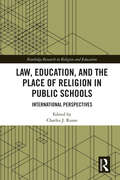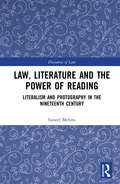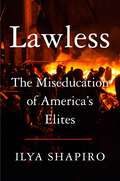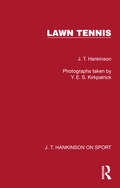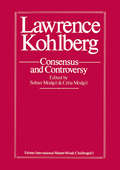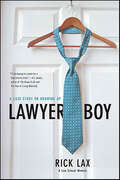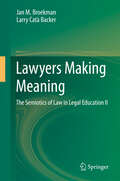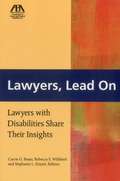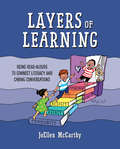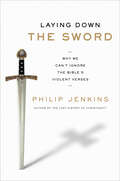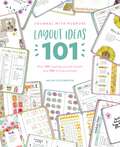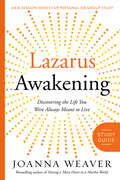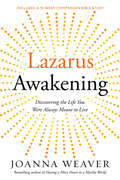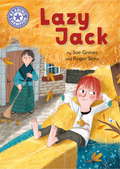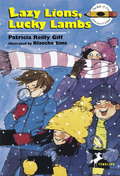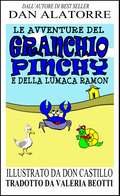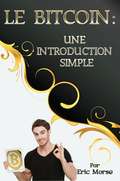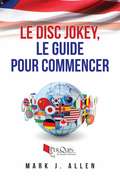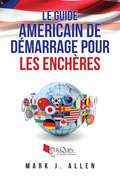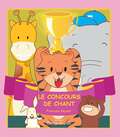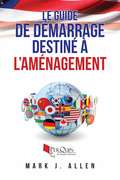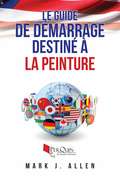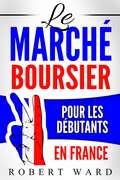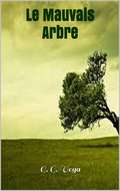- Table View
- List View
Law, Education, and the Place of Religion in Public Schools: International Perspectives (Routledge Research in Religion and Education)
by Charles J. RussoThis text presents a comparative, cross-cultural analysis of the legal status of religion in public education in eighteen different nations while offering recommendations for the future improvement of religious education in public schools. Offering rich, analytical insights from a range of renowned scholars with expertise in law, education, and religion, this volume provides detailed consideration of legal complexities impacting the place of religion and religious education in public education. The volume pays attention to issues of national and international relevance including the separation of the church and state; public funding of religious education; the accommodation of students’ devotional needs; and compulsory religious education. The volume thus highlights the increasingly complex interplay of religion, law, and education in diverse educational settings and cultures across developing and developed nations. Providing a valuable contribution to the field of religious secondary education research, this volume will be of interest to researchers, academics, and educators with an interest in religion and law, international and comparative education, and those involved with educational policy at all levels. Those more broadly interested in moral and values education will also benefit from the discussions the book contains.
Law, Education, and the Place of Religion in Public Schools: International Perspectives (Routledge Research in Religion and Education)
by Charles J. RussoThis text presents a comparative, cross-cultural analysis of the legal status of religion in public education in eighteen different nations while offering recommendations for the future improvement of religious education in public schools. Offering rich, analytical insights from a range of renowned scholars with expertise in law, education, and religion, this volume provides detailed consideration of legal complexities impacting the place of religion and religious education in public education. The volume pays attention to issues of national and international relevance including the separation of the church and state; public funding of religious education; the accommodation of students’ devotional needs; and compulsory religious education. The volume thus highlights the increasingly complex interplay of religion, law, and education in diverse educational settings and cultures across developing and developed nations.Providing a valuable contribution to the field of religious secondary education research, this volume will be of interest to researchers, academics, and educators with an interest in religion and law, international and comparative education, and those involved with educational policy at all levels. Those more broadly interested in moral and values education will also benefit from the discussions the book contains.
Law, Literature and the Power of Reading: Literalism and Photography in the Nineteenth Century
by Suneel MehmiAt the intersection of law, literature and history, this book interrogates how a dominant contemporary idea of law emerged out of specific ideas of reading in the nineteenth century. Reading shapes our identities. How we read shapes who we are. Reading also shapes our conceptions of what the law is, because the law is also a practice of reading. Focusing on the works of key Victorian writers closely associated with legal practice, this book addresses the way in which the identity of the reader of law has been modelled on the identity of the political elite. At the same time, it shows how other readers of law have been marginalized. The book thus shows how a construction of the law has emerged from the ordering of a power that discriminates between different readers and readings. More specifically, and in response to the emerging media of photography – and, with it, potentially subversive ideas of exposure and visibility – the book shows that there have been dominant, hidden and unrecognised guides to legal reading and to legal thought. And in making these visible, the book also aims to make them contestable. This secret history of law will appeal to legal historians, legal theorists, those working at the intersection of law and literature and others with interests in law and the visual.
Lawless: The Miseducation of America's Elites
by Ilya ShapiroIn the past, Columbia Law School produced leaders like Franklin Delano Roosevelt and Ruth Bader Ginsburg. Now it produces window-smashing activists.When protestors at Columbia broke into a building and created illegal encampments, the student-led Columbia Law Review demanded that finals be canceled because of “distress.”Law schools used to teach students how to think critically, advance logical arguments, and respect opponents. Now those students cannot tolerate disagreement and reject the validity of the law itself. Rioting Ivy Leaguers are the same people who will soon:Be America’s judges, DAs, and prosecutorsFile and fight constitutional lawsuitsAdvise Fortune 500 companiesHire other left-wing diversity candidates to staff law firms and government officesRun for higher office with an agenda of only enforcing laws that suit left-wing whimsIn Lawless, Ilya Shapiro explains how we got here and what we can do about it. The problem is bigger than radical students and biased faculty—it’s institutional weakness. Shapiro met the mob firsthand when he posted a controversial tweet that led to calls for his firing from Georgetown Law. A four-month investigation eventually cleared him on a technicality but declared that if he offended anyone in the future, he’d create a “hostile educational environment” and be subject to the inquisition again. Unable to do the job he was hired for, he resigned.This cannot continue. In Lawless, Shapiro reveals how the illiberal takeover of legal education is transforming our country. Unless we stop it now, the consequences will be with us for decades.
Lawn Tennis (J. T. Hankinson on Sport)
by J. T. HankinsonOriginally published in 1951, in Lawn Tennis Mr Hankinson produced something that was outstandingly original at the time. The intention was to teach the game from the very beginnings, and to this end the written description was reduced to a minimum, and, so far as possible, the teaching was built up round the photographs. In some of these Mr Hankinson introduced four most life-like puppets, which he named the Lawn Tennis Quads, and they most effectively demonstrate the principles of the basic strokes. They are supported by action shots of young players. The author also constructed a model lawn tennis court, and to illustrate the more simple tactical situations of the game the puppets were invited to play singles and doubles on this court.The author’s previous titles had been very successful and yet this new volume seemed to reach a new level of carefully planned instruction. The introduction of the puppets was said to be a stroke of genius, and the skill shown in setting them up to demonstrate the technique of the strokes was masterly. The pictorial ingenuity may have overshadowed the text, but, apart from the more descriptive items there are stimulating chapters entitled “How to Watch a Match” and “Yourself and the Game.” Today it can be enjoyed in its historical context.
Lawrence Kohlberg
by Mark WoodwardFirst published in 1986. Routledge is an imprint of Taylor & Francis, an informa company.
Lawyer Boy: A Case Study on Growing Up
by Rick LaxAfter college, Rick Lax moved back into his parents' house. The closest thing he had to a job was eating his parents' food, sitting on his parents' couch, and watching The Price is Right. An amateur magician, he spent the rest of his time practicing card tricks and rope tricks. And though he could tie four different slipknots, the necktie posed some difficulties.Rick's father, a successful Michigan attorney, told Rick it was time to move out and enter the real world. Rick certainly wasn't going to get a job, so he went to law school instead.This is the story of Rick's journey from childhood to lawyerhood.In Lawyer Boy, Rick uses the skills he developed as a magician to succeed in class, and learns how to become a lawyer without becoming his father. His journey through law school was exhausting, exciting, and infuriating, and, the way he tells it, so funny it's criminal.
Lawyers Making Meaning....
by Jan M. Broekman Larry Catà BackerThis book present a structure for understanding and exploring the semiotic character of law and law systems. Cultivating a deep understanding for the ways in which lawyers make meaning--the way in which they help make the world and are made, in turn by the world they create --can provide a basis for consciously engaging in the work of the law and in the production of meaning. The book first introduces the reader to the idea of semiotics in general and legal semiotics in particular, as well as to the major actors and shapers of the field, and to the heart of the matter: signs. The second part studies the development of the strains of thinking that together now define semiotics, with attention being paid to the pragmatics, psychology and language of legal semiotics. A third part examines the link between legal theory and semiotics, the practice of law, the critical legal studies movement in the USA, the semiotics of politics and structuralism. The last part of the book ties the different strands of legal semiotics together, and closely looks at semiotics in the lawyer's toolkit--such as: text, name and meaning.
Lawyers, Lead On: Lawyers with Disabilities Share Their Insights
by Rebecca S. Williford Carrie A. Basas Stephanie L. EnyartThis inspiring book contains letters of encouragement and advice from lawyers with disabilities to law students and new lawyers with disabilities. The writers share their perspectives on work and disability, based on their own experiences of success and setbacks.
Layers of Learning: Using Read-Alouds to Connect Literacy and Caring Conversations
by JoEllen McCarthyWhat could happen if we viewed every read aloud as an invitation to learn more about literacy and ourselves? In Layers of Learning: Using Read Alouds to Connect Literacy and Caring Conversations , author JoEllen McCarthy explores read aloud strategies designed to enhance your reading and writing standards by capitalizing on the way literature can impact caring communities. Layers of Learning is structured around four key elements: Community, Agency, Respect, and Empowerment, or CARE. The book provides tools necessary to emphasize reading and writing connections, character education, and culturally responsive teaching, all while championing the power of read alouds. Inside you&’ll find: Over 200 picture book suggestions introducing the Heartprint Framework , which demonstrates how you can layer literacy with life lessons 60 read aloud based connections that support caring classroom conversations, lesson planning, and extensions Instructional opportunities for nurturing readers and writers during workshop time, small-group gatherings, or individual conferring sessions Literacy Snapshot photo essays with ideas on how to adopt or adapt Continuing connections with additional resources and invitations for further learning Layers of Learning pulls together the ideas that the books we share not only serve an academic purpose, but also convey big, affective messages. This can lead to richer and more meaningful classroom conversations.
Laying Down the Sword: Why We Can't Ignore the Bible's Violent Verses
by Philip JenkinsCommands to kill, to commit ethnic cleansing, to institutionalize segregation, to hate and fear other races and religions—all are in the Bible, and all occur with a far greater frequency than in the Qur’an. But fanaticism is no more hard-wired in Christianity than it is in Islam. In Laying Down the Sword, “one of America’s best scholars of religion” (The Economist) explores how religions grow past their bloody origins, and delivers a fearless examination of the most violent verses of the Bible and an urgent call to read them anew in pursuit of a richer, more genuine faith.Christians cannot engage with neighbors and critics of other traditions—nor enjoy the deepest, most mature embodiment of their own faith—until they confront the texts of terror in their heritage. Philip Jenkins identifies the “holy amnesia” that, while allowing scriptural religions to grow and adapt, has demanded a nearly wholesale suppression of the Bible’s most aggressive passages, leaving them dangerously dormant for extremists to revive in times of conflict. Jenkins lays bare the whole Bible, without compromise or apology, and equips us with tools for reading even the most unsettling texts, from the slaughter of the Canaanites to the alarming rhetoric of the book of Revelation.Laying Down the Sword presents a vital framework for understanding both the Bible and the Qur’an, gives Westerners a credible basis for interaction and dialogue with Islam, and delivers a powerful model for how a faith can grow from terror to mercy.
Layout Ideas 101: Over 100 inspiring journal layouts plus 500 writing prompts (Journal With Purpose)
by Helen ColebrookThe ultimate guide to journaling, packed with prompts and ideas to spark creativity. For many people who want to keep a journal, the fear of the blank page can be a very real stumbling block, but is definitely something that can be resolved. In this essential guide, journaling expert Helen Colebrook offers up all her knowledge, tips and tricks to ensure you get truly bitten by the journaling bug. Through 101 layout examples, Helen shows you how to approach the design of a myriad of different journal pages, from mood trackers to gratitude spreads, monthly cover pages, daily, weekly and monthly planners, lists, project planners and more. She also covers ideas for junk journaling, adding watercolour to your journal and other ways to develop the artistic side of your journaling. This is a book that will be a constant companion, that you can use for inspiration whenever you need some new ideas for a fresh layout. But it's not just about the aesthetics of your journal ; alongside the layouts Helen gives helpful prompts that will make you think about what you are journaling as much as how. These include thoughtful prompts and exercises to get you started on self-reflection and help you make writing a daily habit, alongside creative prompts to get your creative juices flowing. There are no end of ways to get creative in your journal and it can become a hugely relaxing and rewarding part of the process. The beauty of journaling is that there is no right or wrong, but sometimes we all need a little help and inspiration to help us get the most of this fulfilling hobby. This beautiful book is the perfect companion to Helen's debut book, Journal with Purpose, and alongside her YouTube tutorials and blog, will ensure you have all the tools and ideas you need to make your journal a thing of beauty and personal truth. With 101 layout ideas and 500 journal prompts... there's nothing stopping you from journaling with purpose too!
Lazarus Awakening Study Guide
by Joanna WeaverDo you feel trapped in a tomb of regret, doubt, or fear? Are you tripped up by patterns and behaviors you need to leave behind? Just as Jesus called Lazarus from darkness, He is calling you to come out of the false beliefs and habits that keep you from receiving His unconditional love. He is calling you to know deep in your spirit that God not only loves the world--He loves you. It's time to "come forth!" This eight-session study guide is designed for use with Joanna Weaver's book Lazarus Awakening and the separately available DVD curriculum set, filmed on location in the Holy Land. Join Joanna as she draws you deeper into the historical and spiritual truths we learn from the story of Lazarus: a friend called out from death into the life-giving arms of Jesus. · Designed for both individuals and groups. · Also available: companion DVDs, filmed in the Holy Land and featuring eight 15- to 18-minute sessions.From the Trade Paperback edition.
Lazarus Awakening: Finding Your Place in the Heart of God
by Joanna WeaverYou believe that God loves the world& but sometimes you wonder if He truly loves you. For many of us, moving the truth of God#x19;s love from our heads to our hearts is a lifelong process. As we consider our inadequacies or grieve our shattered dreams, we find it difficult to believe that God cares for us personally. In this life-giving book, Joanna Weaver shows you how to embrace the truth that Jesus loves you apart from anything you accomplish, apart from anything you bring. Just as He called Lazarus forth to new life, Jesus wants to free you to live fully in the light of His love, unbound from the graveclothes of fear, regret, and self-condemnation. Love is calling your name. Combining unforgettable real-life illustrations with unexpected biblical insights, Joanna Weaver invites you to experience a spiritual resurrection that will forever change your understanding of what it means to be the one Jesus loves. Includes 10-week Bible study (adaptable for 8 weeks) for both individual reflection and group discussion.
Lazy Jack: Independent Reading Purple 8 (Reading Champion #173)
by Sue GravesIn this modern adaptation of an Old English story, Jack's mother orders her lazy son to find a job. But each job Jack tries seems to end in disaster... Reading Champion offers independent reading books for children to practise and reinforce their developing reading skills.Fantastic, original stories are accompanied by engaging artwork and a reading activity. Each book has been carefully graded so that it can be matched to a child's reading ability, encouraging reading for pleasure.
Lazy Lions, Lucky Lambs
by Patricia Reilly GiffThe children in Ms. Rooney's room are supposed to be writing about real people, but writing is Beast's worst subject.From the Trade Paperback edition.
Le Avventure Del Granchio Pinchy E Della Lumaca Ramon
by Dan Alatorre“Le Avventure del Granchio Pinchy e Della Lumaca Ramon” racconta la storia di un piccolo granchio che trova una lumaca perduta di nome Ramon.Loro fanno amicizia con una bambina ed un gabbiano, e i quattro lavorano insieme per far tornare a casa Ramon sano e salvo, ma quando non funziona, diventano creativi.Il lavoro di squadra e’ importante, come essere pieni di risorse, aiutare gli altri, farsi nuovi amici diversi da noi, e trarre il meglio da situazioni che per un bambino possono essere difficili, come trasferirsi in una nuova casa.
Le Bitcoin : Une Introduction Simple
by Eric Morse Avinash MayaramComprendre les Bases du Bitcoin Le Bitcoin est une monnaie numérique révolutionnaire qui transforme l’argent tel que nous le connaissons, mais il peut être difficile à comprendre pour l’utilisateur moyen. Plus maintenant ! Ce livre élimine la complexité et enseigne les bases du Bitcoin dans un langage simple et facile à comprendre. Ce n’est pas un manuel. C’est un livre élémentaire non technique qui répond aux questions les plus courantes et importantes que posent les utilisateurs à propos du Bitcoin. Pas de jargon. Pas de bla-bla technologique. Aucune connaissance technique préalable n’est requise. Dans ce livre, vous trouverez les réponses à ces questions : Le Bitcoin, c’est quoi ? Qu’est-ce qui le rend spécial ? La Blockchain, c’est quoi ? Le minage, c’est quoi ? Qui contrôle le Bitcoin ? Le Bitcoin est-il sécurisé ? Le Bitcoin est-il anonyme ? Comment puis-je utiliser le Bitcoin de manière plus sûre ? Devrais-je investir en Bitcoin ? ...Et Bien Plus ! Et Vous n’aurez pas le sentiment d’apprendre une nouvelle langue ou d’obtenir une licence en informatique ! Prérequis : AUCUN ! Si vous avez déjà effectué un achat en ligne, vous avez déjà ce qu’il faut pour comprendre ce livre et apprendre les bases du Bitcoin.
Le Disc Jokey, le guide pour commencer
by Mark J. AllenCe guide «comment» vous montrera des techniques efficaces pour créer une entreprise rentable, même pendant ces périodes économiques incertaines. À la suite de la lecture de ce guide, vous apprendrez des trucs et astuces pour vous aider à démarrer votre entreprise avec un investissement minimal. Vous apprendrez à choisir correctement la structure juridique de votre entreprise. Vous apprendrez également quelles erreurs font les nouveaux propriétaires d'entreprise et comment les éviter! Si vous êtes intéressé à gagner plus d'argent, rapidement, c'est le guide pour vous. En plus de conseils pour gagner du temps, des idées de marketing très efficaces et des secrets d'affaires internes, vous obtiendrez également un plan d'action pas-à-pas facile à comprendre qui élimine l'insécurité habituelle de démarrer votre propre entreprise. Prenez la route pour être votre propre patron et commander aujourd'hui.
Le Guide Americain de Démarrage pour les Enchères
by Mark J. AllenCe guide «comment vous guider» vous montrera des techniques efficaces pour créer une entreprise de vente aux enchères rentable, même pendant ces périodes économiques incertaines. À la suite de la lecture de ce guide, vous apprendrez des astuces et astuces pour vous aider à démarrer votre entreprise avec un minimum d'investissement. Vous apprendrez à choisir correctement la structure juridique de votre entreprise. Vous apprendrez également ce que les propriétaires de nouvelles entreprises font et comment les éviter. Si vous êtes intéressé à gagner plus d'argent, rapidement, c'est le guide pour vous. En plus des astuces pour économiser du temps, des idées de marketing très efficaces et des secrets d'entreprise, vous obtiendrez également un plan d'action étape par étape facile à comprendre qui supprime l'insécurité habituelle du démarrage de votre entreprise. Prenez le chemin d'être votre propre patron et commandez aujourd'hui. Auteur: Mark J. Allen Genre: ENTERPRISE & ÉCONOMIE / Général Sous-genre: ÉDUCATION / Général Langue: Français Mots-clés: Auction, Vente, Enchères
Le concours de chant (Junglidoux #5)
by Francois Keyser Caroline OrliacDans ce livre de la collection des Junglidoux, les amis apprennent qu'un concours de chant va être organisé. Ils veulent tous y participer séparément pour remporter la première place mais réalisent vite que combiner leurs talents pourrait être une meilleure idée. Vont-ils gagner le concours ? Cette histoire de la collection des Junglidoux délivre à ses jeunes lecteurs une morale sur le travail en équipe : nous sommes tous doués pour faire certaines choses individuellement mais on peut parfois accomplir beaucoup plus en unissant nos forces et en travaillant main dans la main.
Le guide de démarrage destiné à l'Aménagement paysager par Mark, J. Allen
by Mark J. AllenCe guide des affaires vous guidera et vous montrera les techniques efficaces qui sont utilisées aux Etats-Unis pour créer des affaires rentables. En lisant ce guide, vous découvrirez les astuces employées pour démarrer vos propres affaires avec un investissement minimal. Vous apprendrez également les erreurs que les nouveaux entrepreneurs devront éviter. Si vous souhaitez gagner rapidement de l'argent, ce guide vous est destiné. En plus des astuces pour gagner du temps, des idées en marketing, des secrets des initiés en affaires, des plans d'action qui feront disparaître progressivement l'incertitude de la création de votre business.
Le guide de démarrage destiné à la peinture écrit par Mark, J. Allen
by Mark AllenCe guide « comment faire » vous montrera les techniques efficaces pour rentabiliser votre activité même pendant les périodes difficiles. En lisant ce guide, vous trouverez les astuces pour démarrer votre affaire avec un investissement minimum. Vous apprendrez comment choisir la structure juridique de votre société. Vous apprendrez également les erreurs que les nouveaux entrepreneurs commettent et comment les éviter. Et si vous voulez gagner de l’argent très rapidement, ce guide vous est destiné. En plus des astuces pour économiser de l’argent, les idées de vente efficace, les secrets, vous comprendrez aussi les plans d’action étape-par-étape qui feront disparaître votre incertitude habituelle quant au démarrage de votre propre affaire. Devenez votre propre patron et ordonnez dès aujourd'hui
Le marché boursier pour les débutants en France
by Robert Ward Bruno LavalLe marché boursier est le lieu où des millions de personnes ont gagné et perdu de l'argent en une année. Je suis certain que vous avez entendu des histoires de gens faisant un tabac sur les marchés boursiers et être tenté d'investir sur le marché boursier français. Je suis in investisseur basé à Londres et j'ai investi et fait de l'argent grâce au marché boursier. Je ne peux pas dire cependant que j'ai perdu sur les actions mais je m'en suis assez bien sortit sur la bourse de Paris. Bien sur il n'y avait personne pour m'aider ainsi des essais et des erreurs ont été faites par mes meilleurs amis. Ce livre est une tentative honnête de rassemblement des bases du marché boursier ainsi les débutants pourront découvrir ce qu'il y a à faire et savoir comment marche le marché boursier français. Les sujets que j'ai couvert sont: 1) Economie et investissement 2) Comprendre le marché boursier pour les débutants en france 3) Comment est-ce que le marché boursier fonctionne en France? Comment est-ce que les marchés financiers s'articulent en France? 4) Quels sont les indices du marché boursier français? 5) Comment acheter des actions en France? 6) Types d'actions sur le marché boursier français 7) Stratégies d'investissements à long terme envers Stratégies d'investissement à court terme 8) FNB pour investissement de long terme
Le mauvais arbre
by G. G. VegaLe monde n’as pas besoin de ceux qui déforestent, car ces individus détruisent l’environnement de leurs enfants ainsi que des autres enfants et les privent petit a petit de l’air nécessaire pour respirer dans le futur. Le monde n'a pas besoin de plus de malédiction qu'il n'en existe et n'a pas besoin non plus d'hommes ayant une mauvaise influence. Les sociétés, les cultures, les nations, sont comme les arbres, tout dépend de leurs racines, de leur profondeur, de leur force et des nutriments qui les rendent solides. Les familles aussi sont en ce sens similaires aux arbres, ainsi que les individus.
